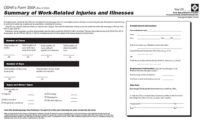Improve Tracking of Workplace Injuries and Illnesses,” a final rule issued by OSHA on May 12, 2016, is precedent-setting. For the first time in OSHA history, establishments with 250 or more employees and establishments with greater than 20 but less than 250 employees in certain named industries must now “electronically” submit information from the three recordkeeping forms these establishments already maintain, namely from the OSHA Forms 300A, 300, and 301.
The final rule also ensures that employees are involved in the recordkeeping system and that the employer cannot take any retaliatory or discriminatory action against an employee for reporting a work-related fatality, injury, or illness or for filing a safety and health complaint.
Deadlines and benefits
The rule becomes effective on January 1, 2017, with two exceptions. Employee involvement and the prohibition of discrimination against an employee for reporting a work-related fatality, injury, or illness become effective on August 10, 2016.
OSHA states “employers, employees, employee representatives, the government, and researchers may be better able to identify and mitigate workplace hazards and thereby prevent worker injuries and illnesses.”1
Where did this idea come from?
Where did this idea of requiring electronic reporting surface?
It appears it started with the publishing of Richard H. Thaler and Cass R. Sunstein’s book, Nudge: Improving Decisions About Health, Wealth, and Happiness2 in February 2009. Later that year, Sunstein became President Obama’s “Regulatory Czar” on his White House staff. Two years later, Sunstein penned a memorandum to all government agencies, “Informing Consumers through Smart Disclosure.” “Smart disclosure” meant “the timely release of complex information and data in standardized, machine-readable formats in ways that enable consumers to make informed decisions.”
On September 15, 2015, President Obama signed Executive Order 13707 Using Behavioral Science Insights to Better Serve the American People. “Behavioral science” equates to “behavioral economics.” Behavioral economics accounts for behaviors when people make economic decisions; traditional economics does not.
Ministry of Truth
We’re moving closer to George Orwell’s Ministry of Truth in his classic novel, 1984.3 The federal government has evolved into a modern-day Ministry of Truth. We all want to be “informed consumers” who can take advantage of “smart disclosures” to make improved decisions about our health, wealth and, of course, our happiness. The problem with all this is the manipulated deception by those controlling the message. We step onto the slippery slope of believing the government is omnipotent.
The notion of “nudge”
The Thaler and Sunstein book presents the notion of Nudge, which involves the government, private organizations, and non-government organizations “nudging” individuals toward actions that are better for them. This assumes these organizations actually know what is better for their audience than the audience knows better for itself. The authors believe that “libertarian paternalism” breaks through contentious debates facing society.4 It pushes people toward better choices without limiting their freedom to choose.
Electronic reporting of injury and illness data makes OSHA the “Choice Architect,” another term of Thaler and Sunstein. By giving the public access to this data OSHA will “nudge” employers to abate hazards and prevent workplace injuries and illnesses, without OSHA having to conduct onsite inspections.
Reading the six mechanisms to “nudge” employers to prevent injuries in the final rule’s preamble, you would think that OSHA believes there is going to be this massive data renaissance. Everyone is going to flood the OSHA website looking for injury and illness data of specific companies -- resulting in their making and changing their economic decisions when it comes to products of companies with high injury rates. This assumes the public will understand what the rates mean. By OSHA’s own admission, after interviewing 2,599 record keepers in 2,836 inspections over a 15-year period, 92 percent indicated that employees never requested access to any record data.
When a nudge is a shove
With all due respect to OSHA, when has the reporting of lagging metrics ever prevented worker injuries and illnesses? Without the context of an injury in hand, employers, employees, employee representatives (i.e., union representatives), the government, and researchers will not have the necessary information to identify and mitigate workplace hazards. At best, OSHA’s stated benefit is overly optimistic and at worst, it is just plain naïve.
Personally, I’m not interested in the government or anyone for that matter telling me what is good for me. When OSHA in this case takes on the role of “nudging,” or as I would say “shoving” employers into what is good for them, we have stepped into the realm of “group think.” Group think stifles creative and systemic innovations to identify hazards and prevent injuries and illnesses.
This “new” and “improved” rule will do nothing more than give OSHA, by its own admission a new tool to more rapidly track down companies with high injury rates in order to take enforcement action. As far as the other altruistic reasons given by OSHA for the new rule, it will have a minimal effect over current efforts by employers to reduce injuries and illnesses in the workplace. Of course, there is always the possibility that the new rule could have the polar opposite effect resulting in the chilling of creative critical thinking.
1 81 FR 29629. May 12, 2016. 29 CFR Part 1904 and 1902. Improve Tracking of Workplace Injuries and Illnesses: Final Rule.
2 Thaler, R.H. and C.R. Sunstein. Nudge: Improving Decisions About Health, Wealth, and Happiness. Penguin Books. New York, NY. 2009.
3 Orwell, G. 1984. Penguin Books. New York, NY. 1949.
4 Op Cit. pp. 252.




